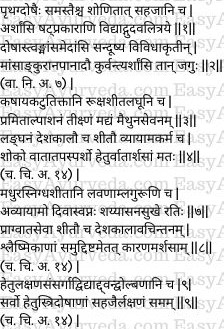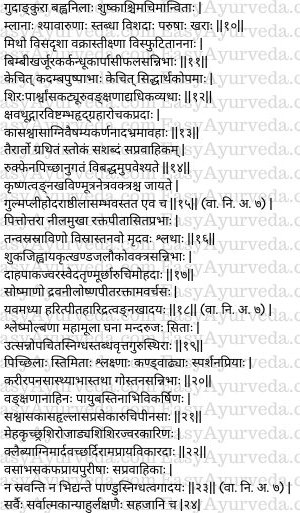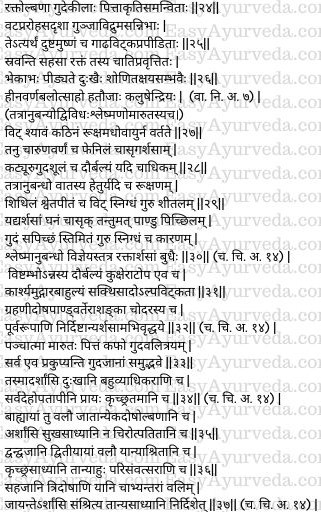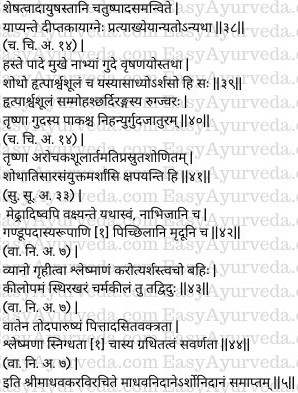Madhava Nidana Chapter 5 Arshas Nidanam
Here in this article we are learning about Madava nidaana 5th chapter “Arshas Nidaanam”. It details about causes, pathology and symptoms of hemorrhoids.
Read – Acharya Madhavakara: His Work ‘Madhava Nidana’, Legacy, Amazing Facts

Table of Contents
Types of Arshas
Arshas (piles, haemorrhoids) is of six types, viz.,
one from each doșa (vataja, pittaja and kaphaja),
fourth from the combination of all three doshas together (tridosaja, sannipataja),
fifth from rakta – blood (raktaja) and
the sixth which is sahaja (congenital / hereditary).
Piles will appear in the three folds of the rectum. (1)
Read – Arshas (Piles), Ayurvedic Types, Causes And Symptoms
Definition of Arsas
The aggravated doshas contaminate the skin, muscle and adipose tissue (fat) and cause sprouts of muscle of different shapes in the rectum (anal region) and other places. These sprouts (Ankura) are called as Arśhas. (2)
Causes of Vataja Arshas
The causes for Vataja Arshas include over-indulgence in foods which are of astringent, pungent or bitter tastes, which are dry, cold, light (easily digestible), very scanty and non-nutritive; strong alcoholic drinks, excessive indulgence in sex, fasting / starvation, exposure to cold season, living in cold places, excessive physical activity, grief, exposure to heavy breeze and sunlight.(3-4)
Read – Ayurvedic Treatment For Non Bleeding Piles: Shushka Arsha Chikitsa
Causes of Pittaja Arshas
The causes of Pittaja Arshas include:
Over-indulgence in foods which are pungent, sour, salt and hot;
physical exertion, too much exposure to fire and sunlight, hot season, living in hot places;
anger, excessive consumption of alcoholic drinks, jealousy, drinks, foods and medicines which cause heart-burn (corrosive),
penetrating (into the tissues) nature and heat producing and other causative factors which lead to increase of pitta. (5-6)
Causes of Kaphaja Arshas

Kshara Application on Arshas
By Dr Ashwin Shetty B.A.M.S., M.S. (Ayu)
Easy Ayurveda Hospital
Click to Consult Dr Ashwin
The causes of Kaphaja Arshas include – over-indulgence in foods which are sweet, fatty, cold, salty, sour and heavy (hard to digest); lack of physical activity, sleeping at daytime, very comfortably soft bed and seat, exposure to eastern breeze, cold season and places, not worrying and others causative factors which lead to increase of kapha. (7-8)
Read – Charaka Samhita Chikitsa Sthana 14 – Arsha Chikitsa
Dvandva and Tridosaja Arshas
Dvandva arshas is produced by the causative factors of any two doshas. These types of arshas will have combined symptoms of aggravation of both those doshas.
Similarly, Tridoshaja arshas is produced by causative factors of all the three doshas. The symptoms of this type of arshas are similar to those of Sahaja arshas (arshas present right from the birth – congenital). (9)

Symptoms of Vataja Arsas
Sprouts (pile masses) are dry (doesn’t exudate or bleed), have itching (tingling sensation), are shrunk (small in size, not developed properly),
blue or bluish pink in colour, stiff (hard), non-sticky (non-slimy),
dry, rough, furrowed, each one of different shape,
curved, pointed tip, cracked,
resemble fruits of bimbi (Cephalandra indica), kharjoora (date palm), karkandhu (Zizyphus ceroplia) and kaarpaasa (cotton seeds).
Some masses appear like kadamba flowers (having many sprouts), and some others resemble mustard seeds (very small in size).
The person complains of excessive pain in the head, flanks, shoulders, waist, thighs, groins, sneezing, belching, constipation, pain near the heart, anorexia, cough, difficult respiration (dyspnoea), irregular digestion, ringing in the ears and giddiness.
The patient eliminates faeces which is scrabulous, scanty, associated with noise, straining and pain; frothy and associated with slimy discharges and semi-solid in consistency or is constipated. There is blackish discoloration of skin, nails, faeces, urine, eyes and face. Gulma (abdominal tumour), pliha (spleen enlargement), udara (enlargement of abdomen) and asthila (enlargement of prostate) may appear as its complications. (10-15)
Symptoms of Pittaja Arshas
Sprouts (pile masses) are blue, red, yellow or black in colour. They will discharge thin blood, fetid smell, less in number (small in size), smooth to touch and suspended (flaccid, loose, hanging).
These masses resemble the parrot’s tongue, piece of liver or mouth part of a leech. The patient complains of burning sensation, suppuration (ulceration), fever, perspiration, thirst, fainting (loss of consciousness), anorexia and delusion.
He eliminates faeces which are hot, watery, blue, yellow or red in colour and not properly processed (associated with ama). Some of these masses will resemble barley i.e. thick in the centre and thin / tapering towards the ends. The skin, nails, face, teeth, urine and faeces will get discoloured and will attain green, yellow or turmeric colour. (16-18)
Symptoms of Kaphaja Arsas
Sprouts (pile masses) are deep rooted, hard (dense), with mild pain, and white in colour. These masses are elongated and elevated, big in size and circumference, unctuous / oily (smooth), stiff (not flabby – do not pit or get depressed when pressed), round in shape, heavy and fixed / stable. The masses are slimy / slippery, immobile (or damp, wet), smooth / shining, associated with severe itching and feels comfortable on touching.
They resemble karira (bamboo shoot/sprout), seed of panasa (jackfruit), or teet of cow udder.
The patient may have swelling or distension in the groins (hernia?), dragging sensation in the rectum, bladder, and umbilicus; difficulty in respiration, cough, nausea, salivation, anorexia, running in the nose, dysuria, heaviness of the head, fever with cold; impotency, indigestion, vomiting and other diseases which are caused by ama (undigested material).
The faeces will resemble fat, mixed with mucus and is accompanied with straining. There will be no exudation (of mucus or blood) from the pile mass. There will also be no cracks and splits in spite of being subjected to friction by faeces. (19-24)
Symptoms of Tridosaja Arsas
In case of Tridosaja arshas the symptoms of all the three dosas will be found together. (23)

Symptoms of Raktarsas (Rakta Arshas)
In case of raktarshas, (bleeding piles) all symptoms are similar to pittaja arshas. The sprouts (pile mass) resemble the shape and size of pittaja arshas. The sprouts will resemble the buds of vata (Ficus bengalensis), seeds of guñja (Abrus precatorius) or vidruma (coral).
There is continuous, frequent and heavy loss (bleeding) of dirty (contaminated) and hot blood from these masses due to the friction of hardened faeces on these masses. Due to heavy and excessive loss of blood, the skin of the patient appears (resembles) that of a monsoon frog (yellowish or greenish brown colour of frogs as evident in the rainy season).
The person will suffer from various disorders due to excessive bleeding. This leads to loss of colour, strength, enthusiasm and ojas (essence of all the tissues) or valour. The senses (sense organs) become weak and the patient may later develop other diseases due to loss of blood. (24-26)
Read – Line Of Treatment For Ardra (Raktaja, Pittaja, Rakta-Pittaja) Arsha
Dosha association in Raktarshas and related symptoms
There are two kinds of dosa associations with Raktarshas i.e. that of vata and kapha.
In case of vata association, the faeces will be black in colour, hard and dry. The flatus is not expelled out.
There occurs thin, red coloured, and frothy blood discharges from the pile mass. The patient would have pain in the waist, thighs and rectum and extreme weakness. Consumption of dry things (foods) are the causative factors of vata aggravation in bleeding piles.
In case of kapha association, the faeces will be broken (semi-solid), whitish yellow in colour, unctuous, heavy and cold.
There will be exudation of thick, sticky, whitish yellow (pale) blood having thread like structures in it from the pile masses. The anal region of the patient will be sticky, and wet (as if covered by wet cloth). Consumption of heavy and unctuous things is the causative factor of kapha aggravation in bleeding piles. (27-30)
Read – Haemorrhoids: Ayurvedic Treatment, Medicines, Remedies
Purvarupa
Purvaroopa – premonitory symptoms of arshas
The premonitory symptoms of arshas include – stasis of food in the stomach without digestion, debility / weakness, gurgling noise in the abdomen, emaciation, too many belchings, weakness of the thighs, scanty faeces, presence of symptoms resembling those of grahani dosha (sprue), pandu (anaemia) and udara (distension of abdomen) causing confusion in diagnosis. (31-32)
Involvement of dosa subtypes and folds of rectum in manifestation of arshas
In the manifestation of arsas vis-a-vis piles, all five subtypes (divisions) of vata, pitta and kapha and all three layers (folds) of rectum are vitiated (affected). All the five divisions of each of the dosas invade (vitiate) all the three layers (folds) of the rectum to produce arshas. So, arshas is a very painful disease and also gives rise to many other diseases. It affects and troubles the whole body and is difficult to cure. (33-34)
Note – The affliction of all the above-mentioned components in the pathogenesis of arshas is limited to gudaja arsas i.e., piles or masses occurring in the anal region. One should have a clear knowledge of the same because ‘pile like masses’ also occur in other areas of the body and they are also called arshas. Example – Nasarsha – mass occurring in the nose which resembles the pile mass. Such types of arshas do not involve the subtypes of doshas and 3 layers of the rectum / anus.
Read – Arshoghna Gana For Hemorrhoids: Review, Benefits, Formulations
Prognosis
Prognosis (curability and incurability) of arshas
Pile masses located in the external layer (fold) of the rectum, those manifested due to increase of any one dosha, and which are of recent onset are easily curable.
Arshas caused by increase of any two doshas together, located in the middle layer (fold) of the rectum and existing for more than a year, are difficult to cure.
The arshas which is congenital (hereditary), which is caused by simultaneous aggravation of all the three doshas, and located in the innermost layer (fold) of the rectum is incurable. (35-37)

Other signs of prognosis of arshas
Patients who are fortunate to have a balance of lifespan (have the fortune of having long life), good services of all the four limbs of treatment (physician, medicine, nurse and patient), having good digestive capacity can hope to live on with arshas. On the other hand the persons in whom none of the above mentioned features are present shall be refused treatment (should not be treated because they are incurable). (38)
Incurability of arshas based on the associated complications
Appearance of oedema in the hands, feet, face, umbilicus, rectum and scrotum, pain in the region of the heart and flanks are symptoms of bad prognosis in arshas.
Pain in the region of the heart and flanks, delusion, vomiting, diffuse pain all over the body, fever, thirst, suppuration (ulceration) of the rectum -these symptoms kill the patients of arshas.
Thirst, anorexia, colic, heavy bleeding from the pile mass, generalized oedema and diarrhoea also kill the patient. (39-41)
Read – How To Make Prognosis Of Disease According To Ayurveda?
Lingaja Arsas
Arsas (sprouts) also develop on the penis and other regions of the body including nose, eyes and ears. The symptoms of these conditions are found along with the disease manifesting in these structures. The arshas manifesting near the umbilicus have the resemblance of the mouth part of earthworm; are slippery and soft. (42)
Carmakila
Vyana (a division / subtype of vata) associated with kapha will invade the skin causing arshas on the skin. This arshas resembles a nail which is firm and rough (hard). This is also known as Carmakila (warts) (43)
Read – Administration of Kshara Sutra in Arshas (piles, haemorrhoids)
Types and symptoms of Carmakila
The carmakila in which vata is predominant is painful and rough. The carmakila in which pitta is predominant would have a black coloured opening. The carmakila in which kapha is predominant is of the same colour of the skin, is unctuous (smooth) and is knotted. (44)

Thus ends the chapter on Arshas, in Madhava Nidana text written by Acharya Madhavakara.











